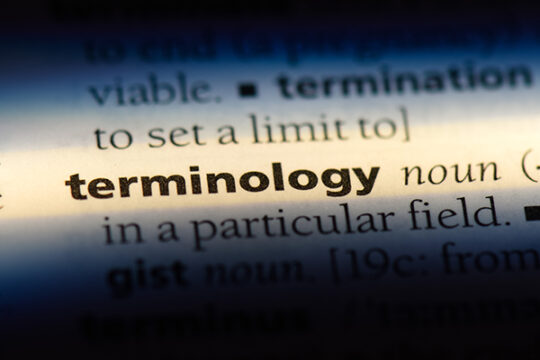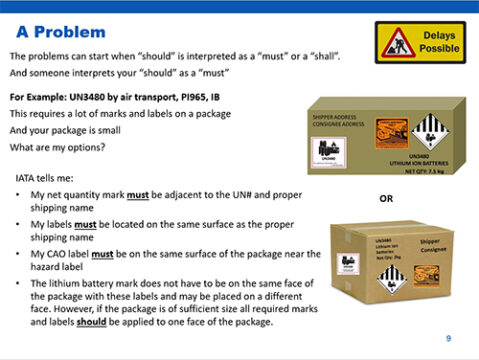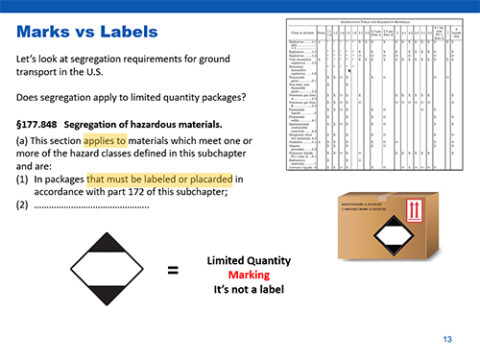
Your typical Dangerous Goods regulatory manual is more than a thousand pages long and may contain close to one million words. How is it possible that four of them could be so important?
According to Labelmaster Senior Manager Jim Shimko, “There are four words that can help you interpret the regulations. And they can work against you when interpreted incorrectly.”
The four indispensable words?
- Must
- Shall
- Should
- May
Shimko described the power of those four words—along with many other insights—in his recent webinar, Dangerous Goods Terminology. Here are some highlights for hazmat novices, career experts and everyone in between.”
The difference between “should” and “must”
So what is it about must, shall, should and may that make them so powerful? Shimko explains what they mean in the context of Dangerous Goods transport:
- What must I do?
- How shall I do it?
- Should I do it a certain way?
- What may I do?
Shimko gives an example of how they differ. “The bylaws of my homeowners’ association say a backyard shed should be out of sight from the street. But the best location in my yard happens to be visible from the street, so I built it there. A neighbor called it in, but I was able to point out that should is a recommendation, not a binding requirement. The shed stayed.”

He shares a similar example concerning a package of UN 3480—standalone lithium ion batteries, Section IB. The IATA DGR says:
- The net quantity mark must be adjacent to the UN number and proper shipping name.
- The labels must be located on the same surface as the proper shipping name.
- The cargo aircraft only label must be on the same surface of the package near the hazard label.
- “The lithium battery mark does not have to be on the same face of the package with these labels.” (IATA Lithium Battery Guidance Document)
- If the package is of sufficient size, all required marks and labels should be applied to one face of the package (IATA Lithium Battery Guidance Document).
“Do your labels and marks all have to be on the same side?” asks Shimko. “No. That’s a recommendation, not a requirement. Best practice is to have all that communication together on the same side, but you can actually place the lithium battery mark anywhere.
“Where you run into problems is when someone interprets a should as a must or makes an interpretation based on unwritten words.”
The words that aren’t there
You would think all those millions of regulatory words would cover everything, right? Not so, says Shimko. “Sometimes it’s about what the book doesn’t say—the words that don’t exist.”

One example relates to segregation of hazardous materials for ground transport, as described in section 177.848 of the 49 CFR. The words in the regulations apply to “packages that must be labeled or placarded.” So doesn’t that mean they apply to all Dangerous Goods packages? No.
“If it’s a limited quantity shipment, it gets a limited quantity mark—which is not a label,” says Shimko, “so those packages have no segregation requirements. The manual could just say that limited quantity shipments don’t need to be segregated, but it doesn’t. You have to learn to understand the context of what you’re reading. It tells you by not telling you.”
“Pick your battles”
Shimko is asked, can a carrier reject your shipment based on their interpretation of should as must? And the answer is yes.
“The regulations state that there’s nothing requiring a carrier to accept your shipment, or stopping them from implementing more restrictive rules,” he says. “In the IATA regulations Carriers will establish a documented variation, but they can have unwritten policies also. And sometimes it’s an individual making a wrong interpretation.”
Then what? Shimko says, “Pick your battles. Work with your carriers—try to understand why they rejected it. Did you make a mistake? Most of us can admit to that. I certainly can. Maybe there’s something you missed. Sometimes they’ll accept your interpretation, sometimes they stand their ground.
“We help our clients with these kinds of issues all the time. There are a lot of words in these publications and interpretating them can be a challenge at times. The key thing is to communicate.”
Stream Dangerous Goods Terminology and other essential hazmat-related webinars with a free membership on the DG Exchange—an online community for supply chain and hazmat professionals.
Make sure your shipments are safe and in complete compliance with a full line of solutions from Labelmaster—a full-service provider of goods and services for hazardous materials and Dangerous Goods professionals, shippers, transport operators and EH&S providers.


